
by Scott Stearns | Jul 13, 2018 | Hidden from Archive
 Acronyms! They are the new language. With the explosion of social media and cell phone texting, an old guy like me really needs to consult a dictionary to see what it all means. I’m a NOOB (newbie) and I easily get confused with all the Instant Message and texting shortcuts. I did not grow up with cell phones and being a self‑proclaimed curmudgeon, I find this new language a bit 2F4M (too fast for me). Unfortunately, the written word keeps evolving, and soon our spoken language will depreciate to nothing but a bunch of letters and numbers that only one generation removed would not comprehend. There are even numbers and symbols representing words 4COL (for crying out loud). For instance, *$ means “Starbucks”. MMA*$ means “meet me at Starbucks”. But **// means “wink‑wink, nudge‑nudge.” I’ve not discovered what three asterisks in a row means yet. 404, I haven’t a clue! Yes, 404 does stand for “haven’t a clue”, but I 404 why. And there is an AAAAA (American Association Against Acronym Abuse). That one had me ROTFL (rolling on the floor laughing). There are even acronyms I’ve used my entire life and didn’t know their true meaning. RSVP has been used on invitations and memos long before texting was around. I knew it meant “Please Respond”. But I did not realize it’s the French equivalent and translates to “Repondez S’il Vous Plait.” Maybe the French were more progressive with their acronyms then we were.
Acronyms! They are the new language. With the explosion of social media and cell phone texting, an old guy like me really needs to consult a dictionary to see what it all means. I’m a NOOB (newbie) and I easily get confused with all the Instant Message and texting shortcuts. I did not grow up with cell phones and being a self‑proclaimed curmudgeon, I find this new language a bit 2F4M (too fast for me). Unfortunately, the written word keeps evolving, and soon our spoken language will depreciate to nothing but a bunch of letters and numbers that only one generation removed would not comprehend. There are even numbers and symbols representing words 4COL (for crying out loud). For instance, *$ means “Starbucks”. MMA*$ means “meet me at Starbucks”. But **// means “wink‑wink, nudge‑nudge.” I’ve not discovered what three asterisks in a row means yet. 404, I haven’t a clue! Yes, 404 does stand for “haven’t a clue”, but I 404 why. And there is an AAAAA (American Association Against Acronym Abuse). That one had me ROTFL (rolling on the floor laughing). There are even acronyms I’ve used my entire life and didn’t know their true meaning. RSVP has been used on invitations and memos long before texting was around. I knew it meant “Please Respond”. But I did not realize it’s the French equivalent and translates to “Repondez S’il Vous Plait.” Maybe the French were more progressive with their acronyms then we were.

But there are some acronyms that are not wise to use, and I learned the hard way to avoid them. Back in the early years of my career, things were not so different than they are today. Clients would wait until the last minute to place orders or had emergencies because they forgot to order something. Then delivery became critical. They’d say they needed their widget ASAP. So, I enter the order with a deliver date ASAP. And because of the customer’s critical time requirement, I also hand carried the order out and personally give it to the shop foreman, assured this action stressed the critical importance of a rush delivery. When the foreman asked me about the delivery date I said “ASAP.” He said “fine.” That is when I learned ASAP had different connotation depending on your viewpoint. Everyone knows ASAP means “as soon as possible” and, in my NOOB naivety, I assumed the foreman would rush it through the shop that very day. A few weeks went by and B4UKI (before you knew it) my client is calling about the delivery for his widgets. Being a little surprised he had not received them yet, I made another visit out to the foreman to inquire about the order. The foreman starts shuffling through a large pile of paperwork on his desk. Near the bottom of the stack he pulls out my order and says, “Here it is.” A little exasperated by this I ask, “They’ve not even been fabricated yet?” The foreman calmly replies that my delivery was “ASAP.” I said, “Exactly. Why hasn’t the order shipped yet?” His answer was simple. All the other orders in the stack had an actual delivery date. He had to meet those dates first before it was “possible” to get my order out. But he assured me he would do it ASAP. That was the last time I put ASAP as a date on a rush order. I still have clients who put ASAP on their orders and I cringe whenever I see it. ASAP also has a few cousins to avoid. AFAP (as fast as possible), NIY (need it yesterday), and ALAP (as late as possible). There is one more danger to avoid. A real word can sometimes be made into an acronym. In my discussion with the foreman I assumed he knew ASAP meant I needed the order rushed through. He said, “ASSUME makes an ass of you and me.”
If you are as confused as I am with this new acronym language, or if you want to get a handle on the secret code your kids are texting (did you know PIR means “parent in room”), you’re in luck. There are many acronym dictionaries on the internet free to download. That is where I got all the acronyms used in this short essay. But if you think this old curmudgeon is going to start texting acronyms to everyone I know, well, GLWT!
Read more

by Scott Stearns | Jul 2, 2018 | Uncategorized
 Imperial Systems is one of the fastest growing and most respected Industrial Dust and Fume collection companies in North America. To supplement this growth, we welcome Tomm Frungillo to our leading group of sales professionals to help take this company to the next level.
Imperial Systems is one of the fastest growing and most respected Industrial Dust and Fume collection companies in North America. To supplement this growth, we welcome Tomm Frungillo to our leading group of sales professionals to help take this company to the next level.
Tomm comes to Imperial Systems Inc. from an extensive career in Industrial Dust and Fume Collection Equipment. Tomm most recently held the position of Director of Sales at The Systems Group and was charged with growing sales globally. Prior to The Systems Group he led many divisions of Camfil APC including Vice President of the Americas.
Prior to serving as Vice President Tomm led teams in charge of growing the Latin America mining market, creating the strategy and equipment for the pharmaceutical and biotechnology market, and growing the thermal spray market for the APC Division. With his 25 years of experience in the industry “We are looking forward to Tomm Joining us by bringing his skill and knowledge to take us to the next level” Says Jeremiah Wann, Owner/CEO Imperial Systems Inc.
Imperial Systems’ growing popularity stems from a reputation of producing the best Dust and Fume Collection Equipment which is backed by an industry-leading 15-year warranty. We believe that Tomm’s experience growing a company through focus on specific market segments will help Imperial Systems continue its path of profitable growth.
Read more
![KST Values of Common Combustible Dusts [Infographic]](https://www.isystemsweb.com/wp-content/uploads/2018/06/KST-Infographic-Featured-image-01-1080x675.jpg)
by Scott Stearns | Jun 25, 2018 | Uncategorized

This infographic identifies the KST values of common metal, chemical, natural, and agricultural dusts found in manufacturing processes. KST is a general measurement of explosiveness and is a standard measurement for dust collection system design purposes. The explosive dust particle size range is between 10 and 95 microns.
Flame Physics
KST is used to determine the speed and pressure of a flame front in the event of an explosion. To calculate the KST values of these common dusts, thermal expansion (K), speed (S), and temperature (T) are used. Once KST is determined, it falls into one of four categories:
- ST-0: Kst 0, Pmax 10
- ST-1: Kst 1-200, Pmax 10
- ST-2: Kst 201-300, Pmax 10
- ST-3: Kst 300 and above, Pmax 12
Descending KST Values of Common Dusts
These common dusts are listed in decreasing order of their KST values. The higher the KST number, the more explosive the dust is. Note that Magnesium dust and Aluminum dust with KST values of 508 and 415, respectively, are extremely explosive. Whereas, Poly Vinyl Chloride (PVC) and Charcoal with KST values of 46 and 10, respectively, are not very explosive. For reference, Sand with a KST value of 0 is not explosive at all. Please note that this information should be used as a reference only and should not be used in place of a dust test.
Explosion Prevention Products
Imperial Systems offers dust collection systems and accessories that help prevent an explosion in your factory. The CMAXX dust and fume collector is certified as an In-Line Deflagration Arrester with DeltaMAXX IDA filters. It has been proven to isolate a deflagration and stop a flame front. We also offer the Spark Trap, an Explosion Isolation Valve, a fast-acting slide gate, and a flameless explosion vent. Our Cast Iron Rotary Airlocks and Rhino Drum explosion-tested drum kit can be used on the discharge of CMAXX or the BRF Baghouse dust collector.
Read more
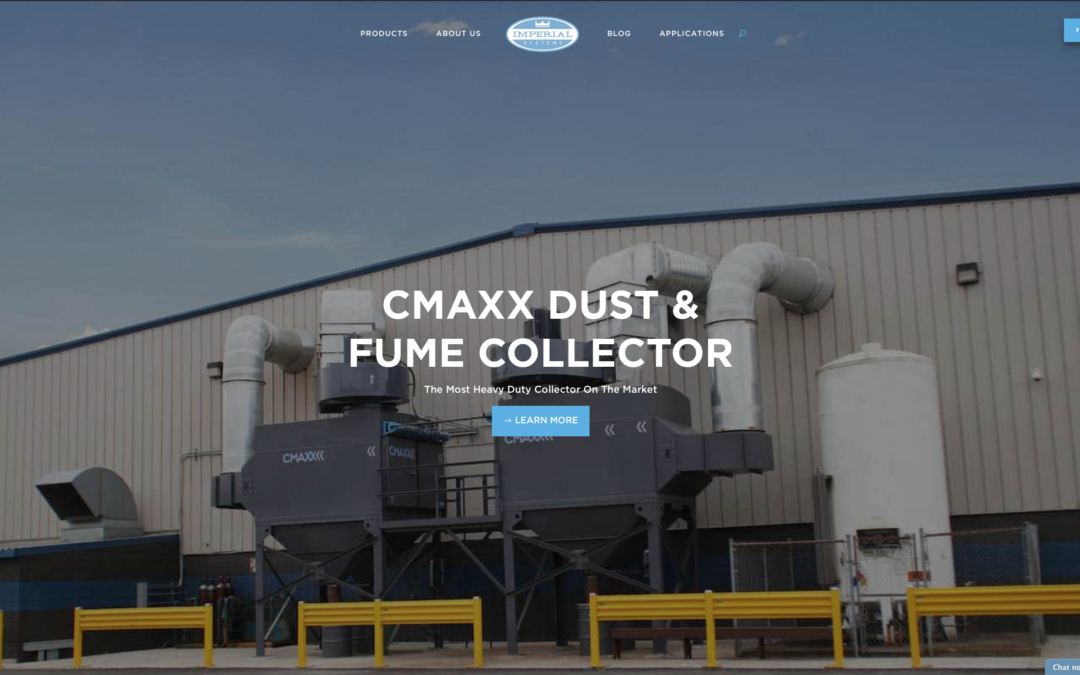
by Scott Stearns | Jun 21, 2018 | Uncategorized
At Imperial Systems we’re very proud of our products and our company, and now they’re finally going to have the website they deserve! The new Imperial Systems website is expected to launch in June, and we think you’ll find many benefits to the new design.
We’ve made our new website easier than ever to navigate, with more streamlined menu options and better navigational tools. You’ll be able to find what you’re looking for more easily than ever. Our new website will also offer:
- Updated product descriptions
- More illustrations and images
- Higher quality graphic design
- New format highlighting key features
- Easy-to-use tools at your fingertips
The new website will offer more images, text, and guidance about each of our products, helping you to find the best options for you and answer your questions more easily. It will continue to feature the same great tools, such as our airflow calculator.
You’ll have easier access to all of our case studies, so you’ll be able to find out more about companies using a process or solving a problem similar to yours and see how the CMAXX or BRF became a key part of one of our customers’ businesses. You’ll also have easier access to all of our blog posts, where you can find information about everything from filters to ductwork to trouble-shooting to company events and stories. Don’t forget to read through our Imperial Systems Quarterly Newsletters to stay up to date on the most exciting and important events happening with the company!
With lots more images, a streamlined design, and a new, cleaner look, we hope you’ll find the new website everything you’d expect from Imperial Systems. From the company that makes the sharpest and cleanest-looking dust collector on the market, you’d expect a website that looks just as good.
Please enjoy our new website and contact us with any questions or comments. We will be working out any bugs during the website’s debut, so please don’t hesitate to let us know if you find anything we need to improve upon!
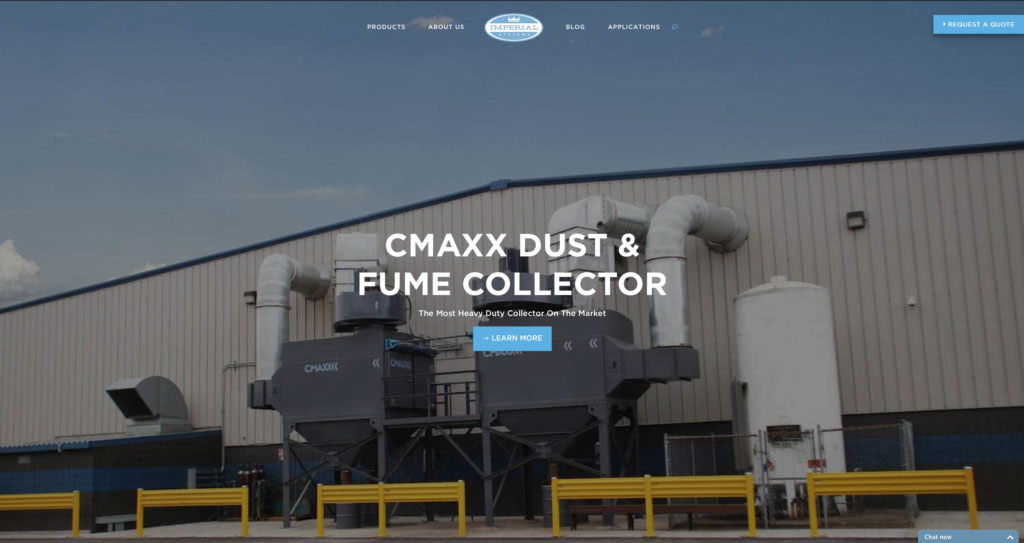
Read more
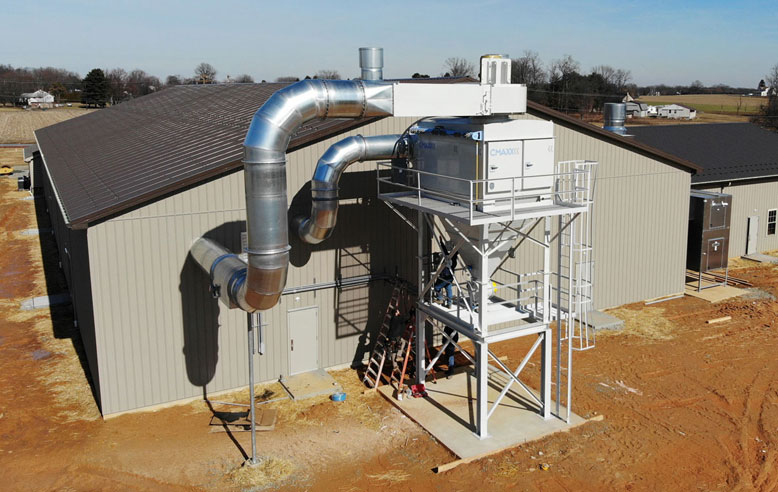
by Scott Stearns | Apr 11, 2018 | Woodworking
In Lancaster, in the heart of the Pennsylvania Amish and Mennonite communities, woodworking is a major industry. Traditionally, the wood shop dust collector system of choice for these furniture and cabinet makers has been the baghouse. However, the CMAXX cartridge dust and fume collector can work just as well as a baghouse on many of these applications. We recently had an opportunity to work with one of our reps, Isaac Lapp from Lapp Millwright, to introduce the CMAXX to a cabinet maker to handle their wood dust. Fortunately, Isaac Lapp and our own Charlie Miller were able to work with this customer to help him design the system he needed.
“Our competitors were in there at the time telling them that a cartridge collector absolutely would not work,” Isaac says. “Charlie was able to show them that it would work, and now it’s there and working great.”
A CMAXX system can be the perfect solution for certain wood dust applications. The efforts of Charlie and Isaac convinced the customer to take the risk of trying a cartridge collector, and now they are very pleased that they did.
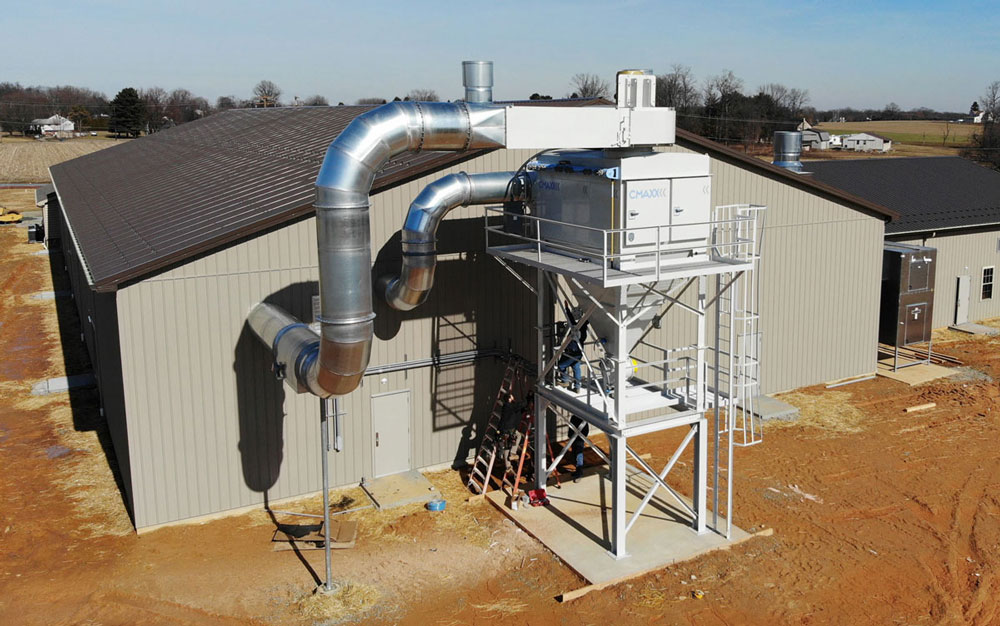
Part of putting the customer at ease about this decision was Charlie’s commitment to walking them through the process from the very early design phases to the end product. In this application, where the capture points are on saws, sanders, and routers, the wood dust is generally very fine. The customer has noted that the system has given them strong airflow on all of the capture points and maintained that airflow, meaning the cartridges are functioning exactly as they should.
For this customer, one of the strongest selling points for the cartridge collector over a baghouse was the size of the collector. A traditional round baghouse would have been nearly 60 feet high to suit the needs of this customer. The CMAXX footprint is very neat and efficient compared to a towering BRF.

This customer needed the wood shop dust collector to be set up so that trucks could drive underneath it. The extra height added by a baghouse would have been excessive. Despite the initial uncertainty about a cartridge collector, it was an option that kept the collector profile much smaller than a baghouse.
Since this customer has seen great success with the CMAXX collector, other customers are making the leap and putting our cartridge collectors on their wood applications. With a “foot in the door” with a cartridge collector at a brand new wood dust facility, others have been willing to take another look.
When one customer sees success with a product, others are more likely to follow, and Isaac reports that he’s getting a much better reception now when suggesting a CMAXX for applications.
Baghouses and cartridge collectors can both work well for woodworking dust collection, but many people are resistant to the idea of cartridge collectors working for wood. The truth is that for many wood shop dust collector applications, a cartridge collector works just as well, and it offers the option of a much smaller footprint, easier maintenance, and excellent efficiency.
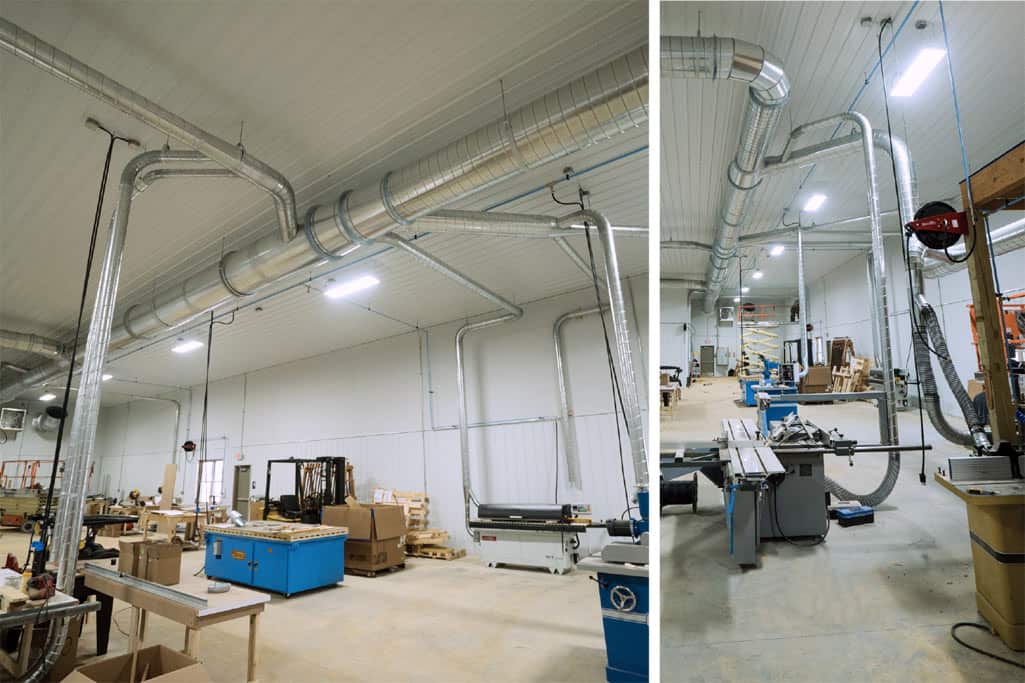
Read more in our blog post: Selecting an Industrial Dust Collector for Woodworking?
Read more

 Acronyms! They are the new language. With the explosion of social media and cell phone texting, an old guy like me really needs to consult a dictionary to see what it all means. I’m a NOOB (newbie) and I easily get confused with all the Instant Message and texting shortcuts. I did not grow up with cell phones and being a self‑proclaimed curmudgeon, I find this new language a bit 2F4M (too fast for me). Unfortunately, the written word keeps evolving, and soon our spoken language will depreciate to nothing but a bunch of letters and numbers that only one generation removed would not comprehend. There are even numbers and symbols representing words 4COL (for crying out loud). For instance, *$ means “Starbucks”. MMA*$ means “meet me at Starbucks”. But **// means “wink‑wink, nudge‑nudge.” I’ve not discovered what three asterisks in a row means yet. 404, I haven’t a clue! Yes, 404 does stand for “haven’t a clue”, but I 404 why. And there is an AAAAA (American Association Against Acronym Abuse). That one had me ROTFL (rolling on the floor laughing). There are even acronyms I’ve used my entire life and didn’t know their true meaning. RSVP has been used on invitations and memos long before texting was around. I knew it meant “Please Respond”. But I did not realize it’s the French equivalent and translates to “Repondez S’il Vous Plait.” Maybe the French were more progressive with their acronyms then we were.
Acronyms! They are the new language. With the explosion of social media and cell phone texting, an old guy like me really needs to consult a dictionary to see what it all means. I’m a NOOB (newbie) and I easily get confused with all the Instant Message and texting shortcuts. I did not grow up with cell phones and being a self‑proclaimed curmudgeon, I find this new language a bit 2F4M (too fast for me). Unfortunately, the written word keeps evolving, and soon our spoken language will depreciate to nothing but a bunch of letters and numbers that only one generation removed would not comprehend. There are even numbers and symbols representing words 4COL (for crying out loud). For instance, *$ means “Starbucks”. MMA*$ means “meet me at Starbucks”. But **// means “wink‑wink, nudge‑nudge.” I’ve not discovered what three asterisks in a row means yet. 404, I haven’t a clue! Yes, 404 does stand for “haven’t a clue”, but I 404 why. And there is an AAAAA (American Association Against Acronym Abuse). That one had me ROTFL (rolling on the floor laughing). There are even acronyms I’ve used my entire life and didn’t know their true meaning. RSVP has been used on invitations and memos long before texting was around. I knew it meant “Please Respond”. But I did not realize it’s the French equivalent and translates to “Repondez S’il Vous Plait.” Maybe the French were more progressive with their acronyms then we were. 

 Imperial Systems is one of the fastest growing and most respected Industrial Dust and Fume collection companies in North America. To supplement this growth, we welcome Tomm Frungillo to our leading group of sales professionals to help take this company to the next level.
Imperial Systems is one of the fastest growing and most respected Industrial Dust and Fume collection companies in North America. To supplement this growth, we welcome Tomm Frungillo to our leading group of sales professionals to help take this company to the next level.![KST Values of Common Combustible Dusts [Infographic]](https://www.isystemsweb.com/wp-content/uploads/2018/06/KST-Infographic-Featured-image-01-1080x675.jpg)






